
Every veteran traveler knows they've hit the jackpot when they are personally introduced to local characters they would not encounter on their own.
So it happens with Ireland in Focus tours in Sligo County Ireland. With a small team of locals escorting our group of fourteen, we were introduced to Sligo as guests, not tourists. How else would we be privileged to eat homemade scones in the hand-built cottage in Blacklion? Or to be treated to private sessions with scholars, craftspeople, musicians and storytellers? How else but through connections would we find ourselves traipsing across a muddy pasture to an ancient dolmen, while the farm's owner sagely advised us to ‘keep to the grassy bits’? Never, on our own, would we have found our way to Temple House, the 18th Century manor home where we stayed, dined, and drew our own pints of Guinness at the honor bar.
We were treated as special guests in Sligo, and knew on the spot this was not the sort of travel experience one takes for granted.
Table of Contents
About County Sligo and Sligo Town
Travelers might visit Ireland many times and not find their way to Sligo. It's in the northwest corner of the Republic of Ireland, bounded by the iconic Ben Bulben mountain and historic Knocknarea mountain, and touched by the Atlantic coast, Lough Gil, and various rivers and waterfalls. Because tourists tend to stay south of the imaginary line that connects Galway with Dublin across the midsection of Ireland, expect few crowds in this region, and plenty of gorgeous natural scenery.
County Sligo's population of 70,600 spreads out across the hills, valleys and coast. Sligo town, with a population of 20,600, ranks only 24th among Ireland's cities, but feels larger considering its port and river and significant history.
That history stretches beyond written record, back to one of Europe’s oldest and largest megalithic landscapes. Carrowmore, the best known of these, includes stone circles and passage tombs marking more than 5,000 years of human presence.
Sligo shares its more recent history with the Republic of Ireland at large. Fortified castles from the Middle Ages gave way to manor homes, the “big houses” built for the Anglo-Irish landed class established in the Elizabethan era.
Sligo has shared in Ireland's various 20th Century challenges: agricultural and political upheavals, famine, repression, mass emigration, economic rebuilding, and the eventual reestablishment of a thriving community. Each of Sligo's nooks and crannies, even the offshore islands, seem to have a unique story of survival.
Sligo is famously known as Yeats Country because of the many references to the area by poet William Butler Yeats: “Under Ben Bulben”, “The Lake Isle of Innisfree”, “The Stolen Child”, and others. While Yeats certainly still drives tourism here, today's visitors are more likely attracted by the coastal walks, the megaliths, the music and culture. No matter the draw, we visitors are following the call of Sligo's motto, “The Land of Heart's Desire.”
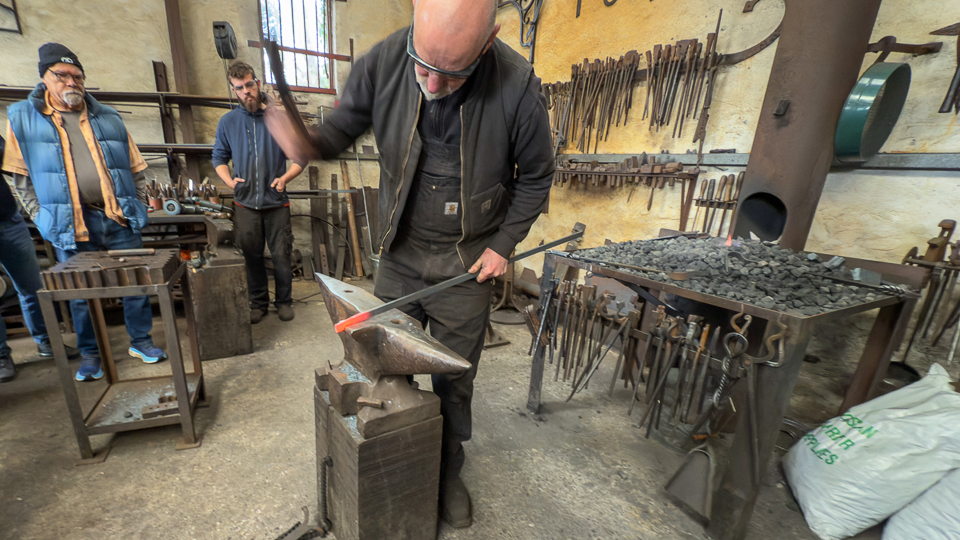
Ireland in Focus: Immersion into Sligo's Local Culture
The highlights for our small group were based on our private sessions with local artists, musicians, scholars and storytellers. It's impossible to re-create those experiences; you had to be there. But we can acknowledge the craftspeople to give you some idea of the company we kept. Follow the links for audio and visual support.
John Ryan Ceramics. John squeezed us in to his workplace and somehow managed to throw a large pot – a pitcher – while talking to us at the same time.
Michael Budd, Master Blacksmith and Sculptor. From restorative work to fanciful art pieces, Michael displayed his expertise at the forge and spoke spontaneously about the nature of blacksmiths. They are exceptionally good at working together, he said, and surprisingly poor at promoting themselves. Let us help!
Joe McGowen. Keeping alive the stories and fairy tales from County Sligo. Extra kudos to Joe for standing by the fire in the light rain to regale us with stories, while we snuggled under blankets with hot chocolate. Look for his work via Amazon or your favorite bookseller.
Brian Leach. His haunting Irish laments on the Uilleann pipes called us to story time beside the fire pit in the castle ruins.
Brídín, one of Ireland's top harpists, who treated us to her music during dinner at Temple House one evening. Check out her work on Apple Music or Spotify.
Damien Brennan. Past-president of Yeats Society Sligo, and warm-hearted host to Yeats scholars and fans who flock to Sligo to find places memorialized in W.B. Yeats' poetry. Damien filled our group in on Yeats' life and family, and treated us to his readings of several poems. Shivers and tears and joy spread around the room as we felt the connection between our location and the poetic sentiments.
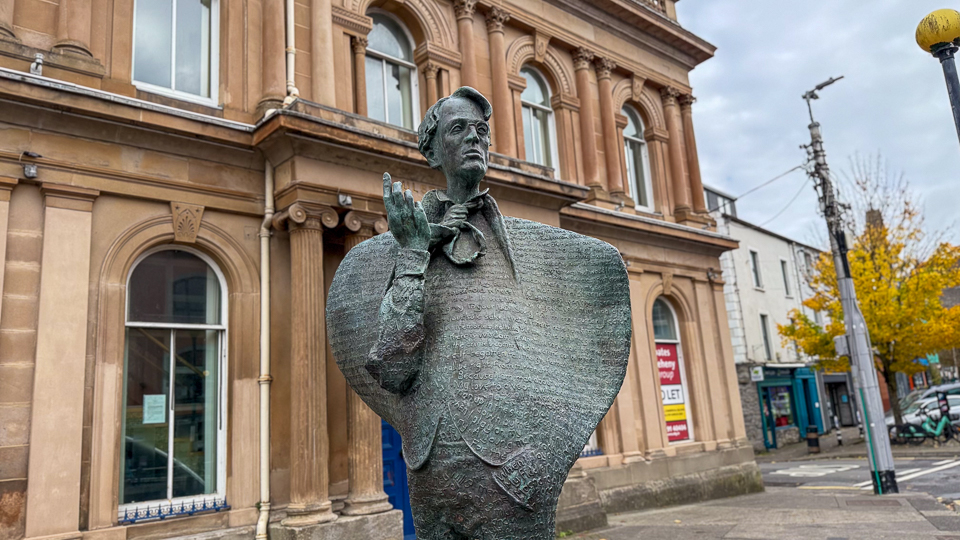
More on Yeats Country
Yeats Society. For Yeats followers and poetry lovers, a visit to the Yeats Society Sligo headquarters is in order. The Yeats Building is conveniently located beside the river at Hyde Bridge. Besides offering exhibits and a gift shop, the Yeats Society hosts writers in residence, summer school programs, and the Hyde Bridge Gallery.
Drumcliffe Churchyard. The site of Yeats' grave with this inscription on his headstone (the last lines of his poem, “Under Ben Bulben”):
Cast a cold Eye
on Life, on Death.
Horsemen pass by.
Visiting Yeats' grave is practically mandatory, as is gazing at Ben Bulben (alternately written Benbulben) every chance you get.
Yeats Trail. To seek out other significant sites from Yeats' ouevre, visit this fun website to get started. (If you're like me, just viewing the illustrated map on the site helps put things in perspective.) Though we didn't spend time around Lough Gil, peppered with Yeats-referenced locales, we did take a walk to Glencar Waterfall, thinking of fairies and this passage from “The Stolen Child.”
Come away, O human child!
To the waters and the wild
With a faery, hand in hand,
For the world's more full of weeping than you can understand.
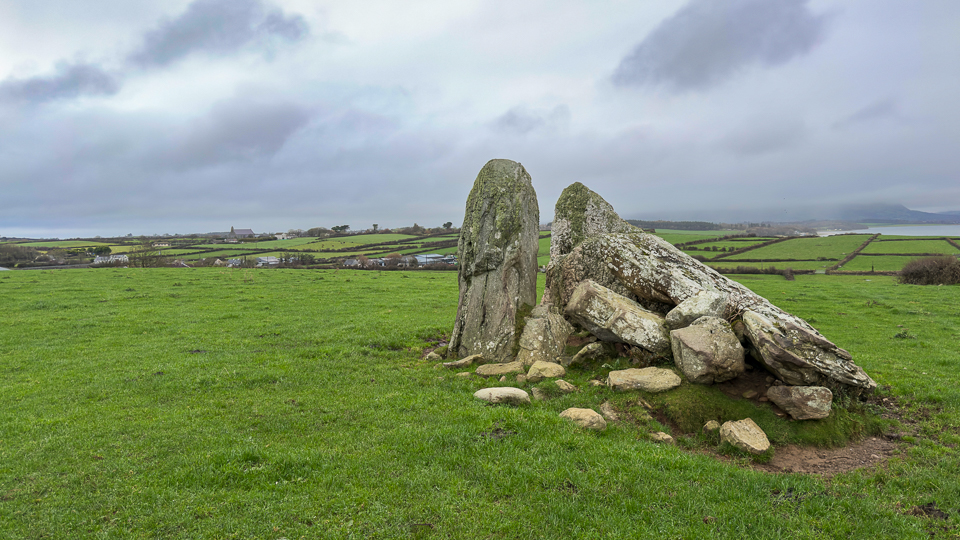
Megaliths and Historic Ruins
Stone circles, dolmen, passage tombs, Queen Maeve’s Grave, stone forts, cursing stones: all these pre-historic monuments conjure images of mythical beings and ancient rituals. What makes Sligo such a special area for megalithic discoveries is the sheer number of ruins found around the county.
The reason so many megalithic ruins remain is exactly because the legends and myths survive, too. Who would dismantle a stone circle when the fairies' promises may still be lingering in the wind? Best not to mess with the fairies, better to leave the stones in place, goes the thinking. It helps, too, that many of the epic characters of Irish mythology lived and loved and fought here in this region.
It's also true that Sligo put up a good fight when neolithic remains were being threatened by development in the 1980s. At issue were not just the ancient monuments, but their relationship to the landscape and each other, creating a newly protected class called archeological landscapes.
With our itinerary full of off-the-beaten-path sites, we skipped a popular megalithic area, the Carrowmore Cemetery (now on the tentative list of UNESCO World Heritage Sites), and instead found hidden gems, right in plain sight on the local farms and hillsides.
Leo's Dolmen. It's not really Leo's of course, but it's on his land. Though Leo, like a few others we met, introduced himself as a simple farmer, his land extends far and his backyard discovery is bolstered by his studies in Landscape Archeaology. The dolmen's shape mirrors the distant mountain, and its position aligns with the autumn solstice.
Cursing Stones. This ancient bullaun (bowl) stone features a number of depressions around the top, each of which cradles a smaller stone. Perhaps in early rituals, the pockets held water. To lay the curse, each of the stones is spun (hefted) counterclockwise three times, one after the other around the big bullaun. Are you thinking of who you want to curse? Beware, if that curse is not a valid one – if its subject isn't deserving of the curse – the curse will boomerang back to haunt you. In our group, only one dared.
Moneygashel Stone Fort. The remains of what was once referred to as “the finest of its kind in Ulster” this cashel (stone fort) was the largest of three in the vicinity. Dating to sometime between 500-1000 AD, it held multiple homes and storage facilities for the farmers who lived here, growing crops and herding. This fort's diameter was 25 meters (82 feet). Glacial melt left plenty of rocks for building such structures, and nearby tombs and stone arrangements date to the Neolithic period.
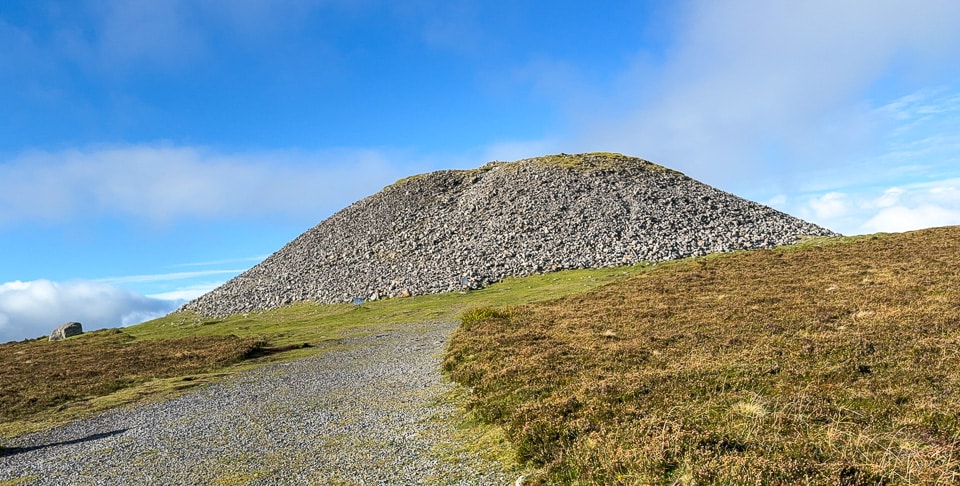
Knocknarea and Queen Maeve's Tomb. This was not a private tour like the others, but a fabulous managed trail up the side of Knocknarea Mountain, through a gate, along a pasture, past a freshwater spring, beside a rainbow, above splendid coastal views, to the massive cairn on top. This is the resting place in honor of the legendary Queen Maeve.
Various stone circles. There might even be more ancient stone circles lying around than graveyards in Sligo, and there are plenty of those.
Holy Wells. Adjacent to the Skreen church, we visited a well dedicated to Adamnan, believed to have established the first church on the site, in the 7th Century. This puts the well much later than the megaliths, of course, but along some continuum from mythology and legend to spirits and religion.
Castle Ruins. No need to drive far before coming upon a castle in this part of the world. A fine example is the Roslee Castle in Easkey, one of the so-called ‘ten pound castles.' That signified it was built under Henry VI's 1429 edict, subsidizing the construction of 20 x 16 x 40 foot castles on the edge of The Pale (that part of Ireland directly under the control of the English government in the Late Middle Ages). Most, like this, were keeps, or tower houses, not fancy castles. It's free to walk inside Roslee Castle, but ascend the steps to the. upper reaches at your own risk.
Lisheen House. More ruins, but from yet another era. The Lisheen House, overgrown with vines and trees, was built in the 19th Century by William Phibbs, who promptly filled it with artifacts he carried home from his travels in Egypt. He was labeled a grave-robber. The spirits, apparently, were none too pleased and proceeded to haunt the house, driving the staff and family away. It was completely abandoned in 1938.
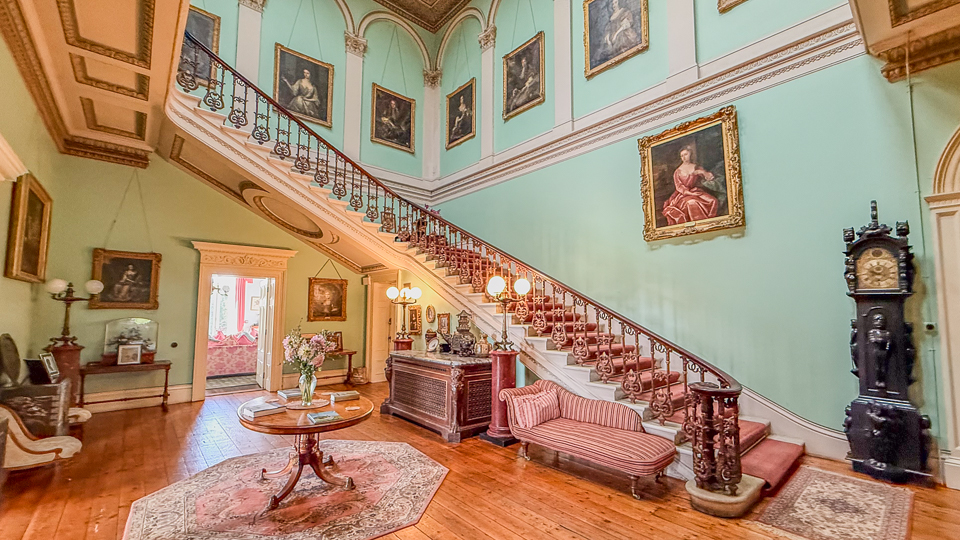
Temple House: Living History
At the center of our exclusive Ireland in Focus treatment, was the week's stay at Temple House in Ballymote, County Sligo. Our group took over the entire house, except for the owners' quarters, of course. We were welcome to sit in the morning room, build a fire in the sitting room, gather for breakfasts and excellent dinners, and generally make ourselves at home. We were also welcome to explore the picturesque 1,000 acre property.
The story of Temple House represents a period of history in Ireland, and also departs from it. It is one of the few manor homes in Ireland to remain in the same (Perceval) family, in this case over 14 generations, albeit with a short interruption in the 19th Century. It's unique, too, in that the ruined castle homes of earlier tenants – Knights Templars in the 12th Century (hence the name Temple House) and Knights Hospitallers in the 14th Century, still stand on the property.
Though the Perceval connections can be traced back even earlier, the family first took up residence here in 1665. They lived in the rebuilt castle until 1760, when the current home was first constructed.
As it was across Ireland, from the late 1600s these “big houses” were exclusively Anglo Irish manor homes – built by the Protestant ruling class on land confiscated from Irish, and supported by the agriculture and rent paid by the working tenants. There were an estimated 4,000 big houses operating in the 1800s. With economic power came political power, as landowners' sons were often elected to seats in the Irish house of Commons.
Today, only a few dozen remain. Many were destroyed during the Irish revolutionary period, and many more abandoned. From 1919 to 1923, with the Great Famine, mass emigration, and social agitation, a Land Purchase Act was initiated to incent landlords to sell off their estates. Hundreds were burned or destroyed, and hundreds more simply abandoned.
Notably, Temple House was spared destruction by the locals, because its 19th Century owners, and Jane Perceval specifically, were known for their care and concern for workers, supplying food and medicine to the needy.
Seen from our bedroom window, history seems to be painted onto the landscape. Castle ruins rest beside the Temple House lake. The woods all around are ready for the season's hunt, and the lake and gardens take on tones of slow reflection and lazy boat rides.
Inside, it's clear that the home and property are works in progress. Current owners Roderick and Helen Perceval are keenly aware of past and future generations as they adapt the property to the current market. To our delight, the direction is toward accommodating groups like ours for a “take-over” of the heritage home. To that end, they've built a big beautiful kitchen, and continue to update the rooms and land. Our delicious evening meals were the work of guest chef Karol Kowalczyk, also head chef of Lovage in nearby Boyle.
Our best evenings were gathered at Temple House, beside the fire, enjoying the company of our new Ireland in Focus friends.
Read more about the history of Temple House and Perceval connections to King Arthur here.

On the Wild Atlantic Way
As much as the music and crafts and megaliths represent Sligo, so does the coast. Whether walking on shoreline rocks, high cliffs, or sandy dunes, the power of the place is maximized along the wild Atlantic coast. Ireland's popular Wild Atlantic Way passes through Sligo for those who want to immerse themselves in the unadulterated elements.
Strandhill. This trendy spot on the tip of the peninsula (near the base of Knocknarea) is famous for its dune landscapes, beach walks, the fresh fare at Honestly Farm Kitchen, and Mammy Johnston's ice cream shop.
Streedagh Point. Get a feel for the wild and woolly side of Ireland here, where the upper walks may take you around stone circles and across scenic bluffs, and the lower shores will reward you with fossils, rocks and the power of the surf. It's off this coast that three ships of the Spanish Armada were wrecked in September 1588. Over 1,100 sailors were lost.
Mullaghmore Head. Surfers' paradise, and pretty nice for those of us who like to watch, too.
Wild Atlantic Way. From Donegal in the north to County Cork in the south, the sign-posted Wild Atlantic Way can be navigated on your own or with tour companies. The entire route, over 1600 miles, is divided into 14 stages. Jump to the Donegal Bay and Sligo stage info and maps here.

Shopping for Arts and Crafts
Inspired by our encounters with the artisans above, we took time to scatter in Sligo town to see more. Here's a selection of some popular shops in town.
The Model. The Model presents six curated exhibitions from The Niland Collection each year, with a strong focus on Jack Butler Yeats and the Yeats Family during summer months. We were lucky to see Jack Yeats' work on display (see more on the website) and purchased a couple little souvenirs at the gift shop, too.
Made in Sligo Made Sligo Craft Collective is a wonderful place to find talent across media: jewelry, textiles, wood-turning, painting, ceramics and more are represented here.
Inis Aran. Also known as The Woollen Market. Get your Aran knits here, as well as blankets, throws, and classic plaid-patterned accessories.
The Cat and the Moon. Irish designed jewellery, gifts, handcrafts and fine art. I bought a John Ryan mug here, and would have loaded up on more had I been able to pack it!
Pubs in Sligo
Of course we could all have used a bit more time chatting about things to do in Sligo over a pint. Or two. Sligo has the pubs, and the pubs have live music nearly every night.
Shoot the Crows Pub. Pull up to the bar. They reportedly pour the best Guinness in Ireland here. How can you tell? It all as to do with domage, tiltage, and clingage. I can demonstrate next time you buy me a Guinness.
Thomas Connolly Dubbed a heritage pub, since there's been a pub on this site since 1780. Besides the local craft beer, whiskey and gin, Thomas Connolly can set you up with a fine cup of coffee or tea, too. Live music.
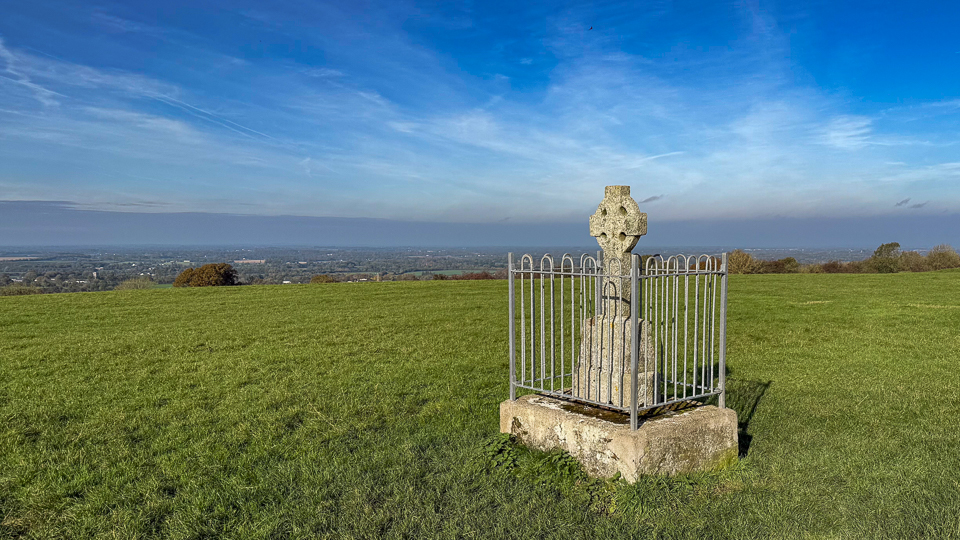
Historic Sites en route to Sligo
On the way to Sligo from our pickup point in Dublin, we stopped at a couple important historic site. These visits went a long way in providing us background, so we recommend you check these out.
Hill of Tara
The Hill of Tara, in County Meath about a half hour from Dublin, is Ireland's primary ancient royal site. As such, it's played a big role in historic events even since the prehistoric times. In ancient times, this was the site of the King's walk and ceremonies. The 1798 rebellion played out here. The famous 1843 speech by Daniel O'Connor is said to have attracted a crowd of a million to this site – back when the entire population of the island was only eight million. Careless digging around the site was stopped in 1902 after pleading by Maude Gonne.
Visitors can walk about imagining the ancient rituals, peer into the ruins of a passage tomb, and visit St. Patrick's church on the edge of the grounds. (The church was closed to visitors when we were there, but look for stained glass windows by Evie Hone.)
Trim Castle
For fun, detour to the town of Trim and visit Trim Castle, the Anglo Norman castle used as a filming location for the movie Braveheart.
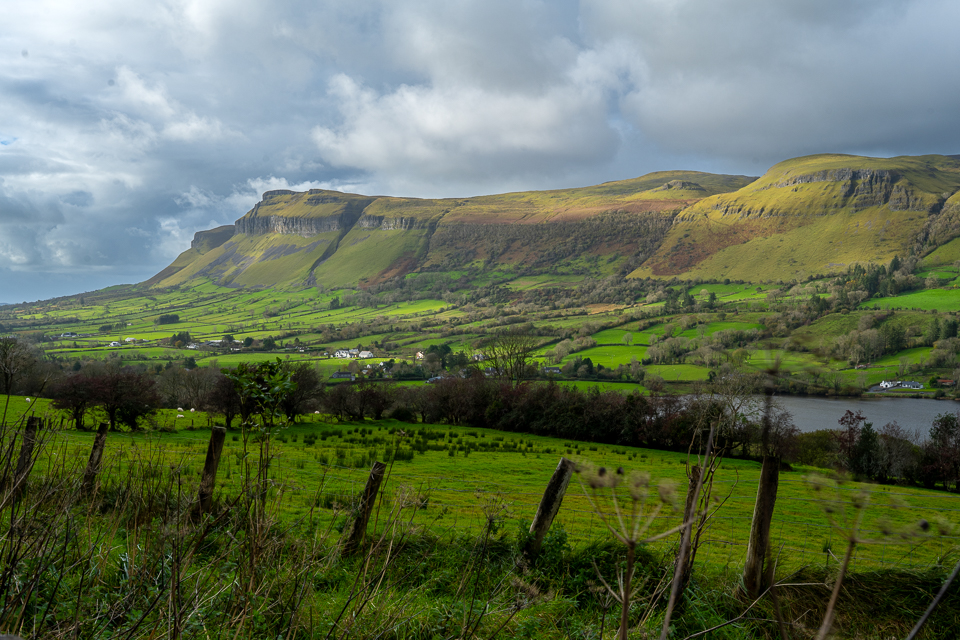
Sligo in Sum: When to Go
In Sligo, history, landscape, and culture blend so seamlessly that exploring the county feels less like sightseeing and more like stepping into an old book, the story still unfolding. Simultaneously, it is down to earth and otherworldly. We're managing to keep the mystery alive weeks later as we read Irish fairy tales, novels, short stories, and poems. It's not hard to imagine ourselves walking the coastline, or peering through fast-moving clouds for a look at Benbulben, or sitting by the fire listening to stories.
The best time to travel to Sligo is between April and October. Most festivals are in summer, naturally the busiest season. In the shoulder seasons, rain can be expected any time, but so can sunshine. Average temperatures in October, when we were there, range from 47 – 57 degrees.
Sligo is easy to get to, but still off the beaten path. We're sorry for those who drive from Galway to the North without stopping in County Sligo.
From Dublin, Sligo is about 3 hours by car, bus or train.
Up Your Travel Skills
Looking to book your next trip? Use these resources that are tried and tested by us. First, to get our best travel tips, sign up for our email newsletter. Then, be sure to start your reading with our Resources Page where we highlight all the great travel companies and products that we trust. Travel Accessories: Check out our list of all the accessories we carry to make getting there and being there a lot easier. Credit Cards: See our detailed post on how to choose the right travel rewards credit card for you. Flights: Start finding the very best flight deals by subscribing to Thrifty Traveler. Book your Hotel: Find the best prices on hotels with Booking.com. See all of the gear and books we like in one place on our Amazon shop.Got a comment on this post? Join the conversation on Facebook, Instagram, or Threads and share your thoughts!

